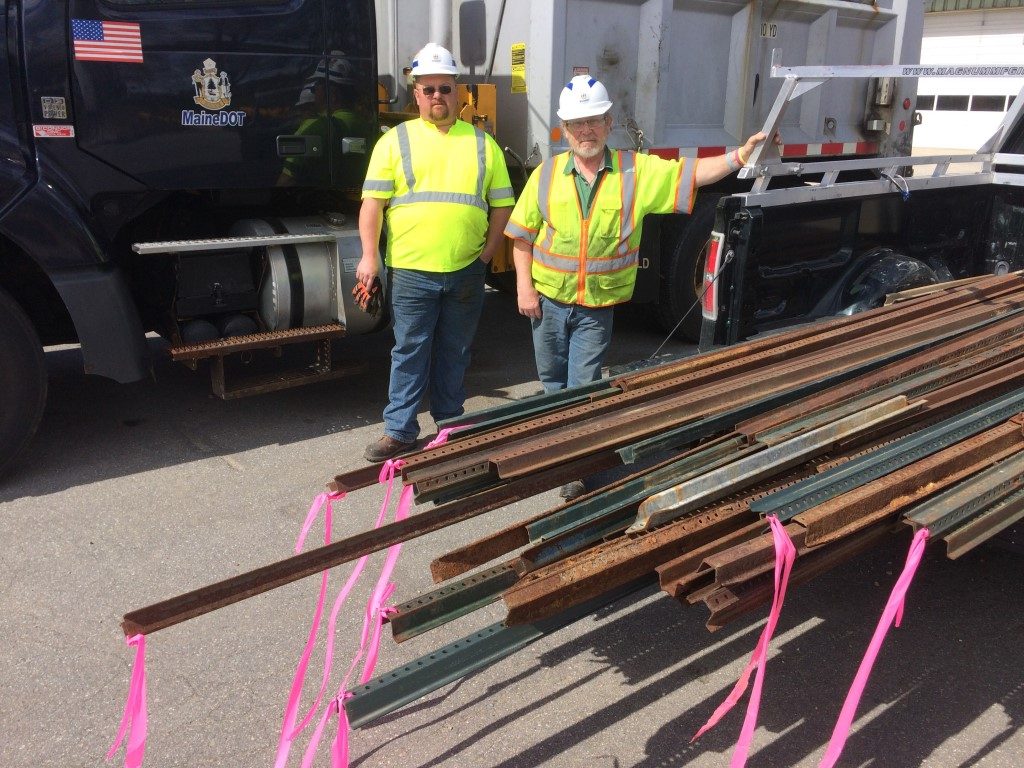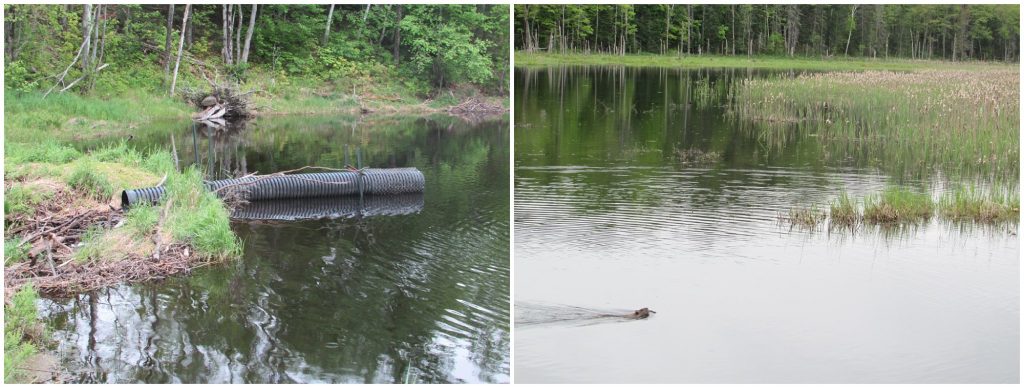June 28, 2017 at 3:36 pm
By Regional Wildlife Biologist Chuck Hulsey and Assistant Regional Wildlife Biologist Bob Cordes, Region D
For the past 28 years the Maine Department of Transportation (MDOT) Region 3 in Dixfield has been supplying our regional wildlife program in western Maine with salvage channel posts. These are the heavy duty metal posts to which DOT affixes stop signs. Instead of going to scrap metal, we give old rusted posts a new life as part of a simple fence and water leveling structure to keep beavers from plugging road culverts.
After a plugged culvert is cleared of mud and sticks, a properly placed fence will get the beaver to build the new dam where we want it, which is well outside the culvert. A half-circle shape fence starting six feet left of the culvert is preferred, extending six feet in front of the culvert, and returning to the road six feet right of the culvert. This arch-shape fence has high structural strength and its surface length greatly exceeds the flow capacity of the culvert. Posts like those seen in the image below are spaced no more than two feet apart. So an average culvert requires 12-16 posts. Posts would be the greatest material cost to beaver-proof a culvert. Thanks to MDOT, MDIFW in western Maine has not had to buy a single post in 25 years. We have fixed over 100 problem sites, many of which are on roads maintained by towns. We in turn donate this material to town highway folks along with a design specific to each problem site. In the “what goes around comes around department” many of these posts also end up fixing beaver problems on culverts maintained by MDOT.
The secret to success lies in reaching an amicable agreement with the beavers. Beavers must have sufficient water depth to survive. If unhappy they will work to 24/7 to foil any device we try to deploy. Generally if there is more than a four-foot difference between the water level beavers need and the travel surface of the road, then a fence alone will suffice. If there is less than four feet, then a device to set the water level at an elevation where it won’t be a problem for humans will be needed. The key is to leave the beaver as much water as possible. We loosely call these devices a “water leveler”. The device is placed through the dam and fence, creating a “leak” they cannot easily fix. Ideally, a leak they have no need or desire to fix leads to success for both parties.
In reality, a culvert plugged by beaver is not a wildlife problem, it is a water problem. If the water problem can be resolved then the beaver can remain in place. Keep in mind that every year, a new crop of “teenage” beaver will disperse from their home flowages, seeking places not occupied by other beavers. Also, by maintaining shallow water impoundments, they in turn create high value wildlife habitat for many other wildlife. From songbirds, to mink, to black ducks, beaver flowages are critical to Maine wildlife. If you are a bird watcher, trapper, wildlife photographer, or duck hunter, I bet you never thought of the contribution that MDOT makes to so many species of wildlife which are important to you.
[caption id="attachment_2410" align="aligncenter" width="1024"] Loading salvage channel posts at MDOT in Dixfield for MDIFW regional wildlife biologists in western Maine to use to make fences to beaver-proof road culverts. Shown here are Shawn MacFarlane (L), Transportation Crew Leader and Brian Maxham (R), Transportation Crew Supervisor, MDOT, Region 3, Dixfield.[/caption]
An example of this kind of work can be seen in the photo below. This is a water leveling device that we recently installed on a wetland in Wilton, which has a long history of beaver use, plugged culverts, and flooded roadway. This beaver enhanced wetland also comes with a complicated public interest, as some of the wetted area is town property with a nature trail created around the wetland edge. Many town residents love having the beaver and a higher water level with all the benefits to wildlife. However, there are a fair number of residents that resent the beaver being there and wish to have them removed and would like to see the water level returned to a stream, with a clear culvert and no flooded roadway again.
Loading salvage channel posts at MDOT in Dixfield for MDIFW regional wildlife biologists in western Maine to use to make fences to beaver-proof road culverts. Shown here are Shawn MacFarlane (L), Transportation Crew Leader and Brian Maxham (R), Transportation Crew Supervisor, MDOT, Region 3, Dixfield.[/caption]
An example of this kind of work can be seen in the photo below. This is a water leveling device that we recently installed on a wetland in Wilton, which has a long history of beaver use, plugged culverts, and flooded roadway. This beaver enhanced wetland also comes with a complicated public interest, as some of the wetted area is town property with a nature trail created around the wetland edge. Many town residents love having the beaver and a higher water level with all the benefits to wildlife. However, there are a fair number of residents that resent the beaver being there and wish to have them removed and would like to see the water level returned to a stream, with a clear culvert and no flooded roadway again.
 In an effort to achieve a middle ground, MDIFW worked with the Town of Wilton Public Works Department to install the water leveling device in the photo with the goal of maintaining a water-level that is a compromise -- allowing the beavers to stay, while keeping water off the roadway. There was an arched fence structure (as described above) placed at this site years ago. The beavers had built their dam against the fence, and the while the fence is no longer there, the dam is out of the culvert like we try to achieve with a fencing structure. All that was needed for this site is to bring the water level.
We installed this device in about 2 hours, with materials provided by the town and some salvage materials from MDOT that Chuck mentioned. There are very few beaver-water issues that we are unable to resolve, so if you would like advice on how to live with (an win) with beavers, give the regional office a call at (207) 778-3324.
In an effort to achieve a middle ground, MDIFW worked with the Town of Wilton Public Works Department to install the water leveling device in the photo with the goal of maintaining a water-level that is a compromise -- allowing the beavers to stay, while keeping water off the roadway. There was an arched fence structure (as described above) placed at this site years ago. The beavers had built their dam against the fence, and the while the fence is no longer there, the dam is out of the culvert like we try to achieve with a fencing structure. All that was needed for this site is to bring the water level.
We installed this device in about 2 hours, with materials provided by the town and some salvage materials from MDOT that Chuck mentioned. There are very few beaver-water issues that we are unable to resolve, so if you would like advice on how to live with (an win) with beavers, give the regional office a call at (207) 778-3324.
 Loading salvage channel posts at MDOT in Dixfield for MDIFW regional wildlife biologists in western Maine to use to make fences to beaver-proof road culverts. Shown here are Shawn MacFarlane (L), Transportation Crew Leader and Brian Maxham (R), Transportation Crew Supervisor, MDOT, Region 3, Dixfield.[/caption]
An example of this kind of work can be seen in the photo below. This is a water leveling device that we recently installed on a wetland in Wilton, which has a long history of beaver use, plugged culverts, and flooded roadway. This beaver enhanced wetland also comes with a complicated public interest, as some of the wetted area is town property with a nature trail created around the wetland edge. Many town residents love having the beaver and a higher water level with all the benefits to wildlife. However, there are a fair number of residents that resent the beaver being there and wish to have them removed and would like to see the water level returned to a stream, with a clear culvert and no flooded roadway again.
Loading salvage channel posts at MDOT in Dixfield for MDIFW regional wildlife biologists in western Maine to use to make fences to beaver-proof road culverts. Shown here are Shawn MacFarlane (L), Transportation Crew Leader and Brian Maxham (R), Transportation Crew Supervisor, MDOT, Region 3, Dixfield.[/caption]
An example of this kind of work can be seen in the photo below. This is a water leveling device that we recently installed on a wetland in Wilton, which has a long history of beaver use, plugged culverts, and flooded roadway. This beaver enhanced wetland also comes with a complicated public interest, as some of the wetted area is town property with a nature trail created around the wetland edge. Many town residents love having the beaver and a higher water level with all the benefits to wildlife. However, there are a fair number of residents that resent the beaver being there and wish to have them removed and would like to see the water level returned to a stream, with a clear culvert and no flooded roadway again.
 In an effort to achieve a middle ground, MDIFW worked with the Town of Wilton Public Works Department to install the water leveling device in the photo with the goal of maintaining a water-level that is a compromise -- allowing the beavers to stay, while keeping water off the roadway. There was an arched fence structure (as described above) placed at this site years ago. The beavers had built their dam against the fence, and the while the fence is no longer there, the dam is out of the culvert like we try to achieve with a fencing structure. All that was needed for this site is to bring the water level.
We installed this device in about 2 hours, with materials provided by the town and some salvage materials from MDOT that Chuck mentioned. There are very few beaver-water issues that we are unable to resolve, so if you would like advice on how to live with (an win) with beavers, give the regional office a call at (207) 778-3324.
In an effort to achieve a middle ground, MDIFW worked with the Town of Wilton Public Works Department to install the water leveling device in the photo with the goal of maintaining a water-level that is a compromise -- allowing the beavers to stay, while keeping water off the roadway. There was an arched fence structure (as described above) placed at this site years ago. The beavers had built their dam against the fence, and the while the fence is no longer there, the dam is out of the culvert like we try to achieve with a fencing structure. All that was needed for this site is to bring the water level.
We installed this device in about 2 hours, with materials provided by the town and some salvage materials from MDOT that Chuck mentioned. There are very few beaver-water issues that we are unable to resolve, so if you would like advice on how to live with (an win) with beavers, give the regional office a call at (207) 778-3324.Categories